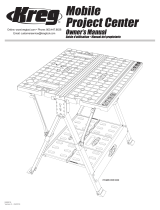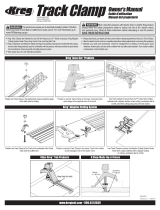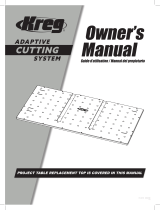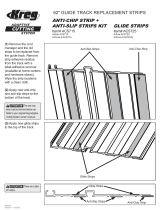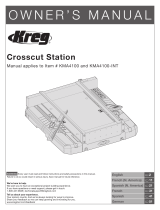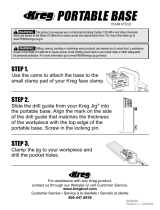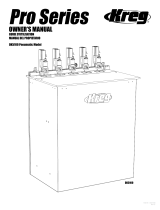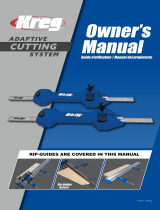Page is loading ...

ADAPTIVE
SYSTEM
11/2018 NK9354
V1
Owner’s
Manual
Guide d’utilisation / Manual del propietario
Plunge Saw
(ACS-SAW)
62" Guide Track
(ACS430)
Guide Track Connectors
(ACS445)
Saw Splinter Guard
(ACS735)
Saw Blade
(ACS705)
PRODUCTS COVERED IN THIS MANUAL
7000
MAX
RPM
(165mm)
6.5"
8˚
ATB
KPS6512

GENERAL SAFETY GUIDELINES
WARNING
!
Read all safety warnings, instructions, illustrations and specications provided with this power tool. Failure to follow all instructions listed
below may result in electric shock, re and/or serious injury.
SAVE ALL WARNINGS AND INSTRUCTIONS FOR FUTURE REFERENCE
The term "power tool" in the warnings refers to your mains-operated (corded)
power tool or battery-operated (cordless) power tool.
1) Work area safety
a) Keep work area clean and well lit. Cluttered or dark areas invite accidents.
b) Do not operate power tools in explosive atmospheres, such as in
thepresenceofammableliquids,gasesordust.Powertools
createsparkswhichmayignitethedustorfumes.
c)Keepchildrenandbystandersawaywhileoperatinga
power tool. Distractions can cause you to lose control.
2) Electrical safety
a)Powertoolplugsmustmatchtheoutlet.Nevermodifythe
pluginanyway.Donotuseanyadapterplugswithearthed
(grounded)powertools.Unmodiedplugsandmatching
outlets will reduce risk of electric shock.
b)Avoidbodycontactwithearthedorgroundedsurfaces,suchas
pipes,radiators,rangesandrefrigerators.Thereisanincreased
riskofelectricshockifyourbodyisearthedorgrounded.
c) Do not expose power tools to rain or wet conditions. Water
enteringapowertoolwillincreasetheriskofelectricshock.
d)Donotabusethecord.Neverusethecordforcarrying,
pullingorunpluggingthepowertool.Keepcordawayfrom
heat,oil,sharpedgesormovingparts.Damagedor
entangledcordsincreasetheriskofelectricshock.
e)Whenoperatingapowertooloutdoors,useanextension
cordsuitableforoutdooruse.Useofacordsuitablefor
outdoor use reduces the risk of electric shock.
f)Ifoperatingapowertoolinadamplocationisunavoidable,
useagroundfaultcircuitinterrupter(GFCI)protectedsupply.
UseofaGFCIreducestheriskofelectricshock.
3) Personal safety
a)Stayalert,watchwhatyouaredoingandusecommonsense
whenoperatingapowertool.Donotuseapowertool
whileyouaretiredorundertheinuenceofdrugs,alcoholor
medication.Amomentofinattentionwhileoperatingpower
tools may result in serious personal injury.
b)Usepersonalprotectiveequipment.Alwaysweareye
protection.Protectiveequipmentsuchasdustmask,non-
skidsafetyshoes,hardhat,orhearingprotectionusedfor
appropriate conditions will reduce personal injuries.
c)Preventunintentionalstarting.Ensuretheswitchisinthe
o-positionbeforeconnectingtopowersourceand/orbattery
pack,pickinguporcarryingthetool.Carryingpowertools
withyourngerontheswitchorenergizingpowertoolsthat
have the switch on invites accidents.
d)Removeanyadjustingkeyorwrenchbeforeturningthe
powertoolon.Awrenchorakeyleftattachedtoarotating
part of the power tool may result in personal injury.
e)Donotoverreach.Keepproperfootingandbalanceatall
times.Thisenablesbettercontrolofthepowertoolin
unexpected situations.
f)Dressproperly.Donotwearlooseclothingorjewelry.Keepyour
hair,clothingandglovesawayfrommovingparts.Looseclothes,
jewelryorlonghaircanbecaughtinmovingparts.
g)Ifdevicesareprovidedfortheconnectionofdustextractionand
collection facilities, ensure these are connected and properly
used.Useofdustcollectioncanreducedust-relatedhazards.
h)Donotletfamiliaritygainedfromfrequentuseoftoolsallowyouto
becomecomplacentandignoretool-safetyprinciples.Acareless
action can cause severe injury within a fraction of a second.
4) Power tool use and care
a)Donotforcethepowertool.Usethecorrectpowertoolfor
yourapplication.Thecorrectpowertoolwilldothejobbetter
andsaferattherateforwhichitwasdesigned.
b) Do not use the power tool if the switch does not turn it on
ando.Anypowertoolthatcannotbecontrolledwiththe
switchisdangerousandmustberepaired.
c)Disconnecttheplugfromthepowersourceand/orremove
the battery pack, if detachable, from the power tool before
makinganyadjustments,changingaccessories,orstoring
power tools Such preventive safety measures reduce the
riskofstartingthepowertoolaccidentally.
d) Store idle power tools out of the reach of children and do
not allow persons unfamiliar with the power tool or these
instructions to operate the power tool. Power tools are
dangerousinthehandsofuntrainedusers.
e)Maintainpowertoolsandaccessories.Checkformisalignment
orbindingofmovingparts,breakageofpartsandanyother
conditionthatmayaectthepowertooloperation.Ifdamaged,
have the power tool repaired before use. Many accidents are
caused by poorly maintained power tools.
f)Keepcuttingtoolssharpandclean.Properlymaintained
cuttingtoolswithsharpcuttingedgesarelesslikelyto
bind and are easier to control.
g)Usethepowertool,accessoriesandtoolbitsetc.
inaccordancewiththeseinstructions,takingintoaccount
theworkingconditionsandtheworktobeperformed.
Useofthepowertoolforoperationsdierentfrom
thoseintendedcouldresultinahazardoussituation.
h)Keephandlesandgraspingsurfacesdry,clean,
andfreefromoilandgrease.Slipperyhandlesand
graspingsurfacesdonotallowforsafehandling
and control of the tool in unexpected situations.
5) Service
a)Haveyourpowertoolservicedbyaqualiedrepairperson
usingonlyidenticalreplacementparts.Thiswillensurethat
the safety of the power tool is maintained.
Safety instructions for all saws
1)Cuttingprocedures
a)
DANGER
!
Keephandsawayfromcuttingareaandtheblade.
Keepyoursecondhandonauxiliaryhandle,ormotorhousing.
Ifbothhandsareholdingthesaw,theycannotbecutbytheblade.
b)Donotreachunderneaththeworkpiece.Theguardcannot
protect you from the blade below the workpiece.
c)AdjustthecuttingdepthtothethicknessoftheworkpieceLessthan
a full tooth of the blade teeth should be visible below the workpiece.
d) Never hold the workpiece in your hands or across your
legwhilecutting.Securetheworkpiecetoastableplatform.
Itisimportanttosupporttheworkproperlytominimizebody
exposure,bladebinding,orlossofcontrol.
e)Holdthepowertoolbyinsulatedgrippingsurfaces,when
performinganoperationwherethecuttingtoolmaycontact
hiddenwiringoritsowncord.Contactwitha“live”wirewill
alsomakeexposedmetalpartsofthepowertool“live”and
couldgivetheoperatoranelectricshock.
f)Whenripping,alwaysusearipfenceorstraightedgeguide.This
improvestheaccuracyofcutandreducesthechanceofbladebinding.
g)Alwaysusebladeswithcorrectsizeandshape(diamondversus
round)ofarborholes.Bladesthatdonotmatchthemounting
hardwareofthesawwillruno-center,causinglossofcontrol.
h)Neverusedamagedorincorrectbladewashersorbolt.The
bladewashersandboltwerespeciallydesignedforyoursaw,
for optimum performance and safety of operation.
2)Kickbackcausesandrelatedwarnings
– Kickback is a sudden reaction to a pinched, bound,
ormisalignedsawblade,causinganuncontrolledsaw
to lift up and out of the workpiece toward the operator.
–Whenthebladeispinchedorjammedtightlybythe
kerfclosingdown,thebladestallsandthemotorreaction
drives the unit rapidly back toward the operator.
–Ifthebladebecomestwistedormisalignedinthecut,
theteethatthebackedgeofthebladecandigintothetop
surfaceofthewoodcausingthebladetoclimboutofthe
kerf and jump back toward operator.

GENERAL SAFETY GUIDELINES
Kickback is the result of saw misuse and/or incorrect
operatingproceduresorconditionsandcanbeavoided
bytakingproperprecautionsasgivenbelow.
a)Maintainarmgripwithbothhandsonthesawandposition
your arms to resist kickback forces. Position your body to either
side of the blade, but not in line with the blade. Kickback could
cause the saw to jump backwards, but kickback forces can be
controlled by the operator, if proper precautions are taken.
b)Whenthebladeisbinding,orwheninterruptingacutforany
reason,releasethetriggerandholdthesawmotionless
in the material until the blade comes to a complete stop.
Never attempt to remove the saw from the work or pull the
saw backward while the blade is in motion or kickback may
occur.Investigateandtakecorrectiveactionstoeliminate
thecauseofbladebinding.
c)Whenrestartingasawintheworkpiece,centerthesaw
bladeinthekerfsothatthesawteetharenotengagedin
the material. If a saw blade binds, it may walk up or kickback
from the workpiece as the saw is restarted.
d)Supportlargepanelstominimizetheriskofbladepinching
andkickback.Largepanelstendtosagundertheirown
weight.Supportsmustbeplacedunderthepanelonboth
sides,nearthelineofcutandneartheedgeofthepanel.
e)Donotusedullordamagedblades.Unsharpenedor
improperlysetbladesproducenarrowkerfcausing
excessivefriction,bladebindingandkickback.
f)Blade-depthandbevel-adjustinglockingleversmustbe
tightandsecurebeforemakingthecut.Ifbladeadjustment
shiftswhilecutting,itmaycausebindingandkickback.
g)Useextracautionwhensawingintoexistingwallsorother
blindareas.Theprotrudingblademaycutobjectsthatcan
cause kickback.
Safety instructions for plunge-type saws
1)Guardfunction
a)Checktheguardforproperclosingbeforeeachuse.Donot
operatethesawiftheguarddoesnotmovefreelyand
enclosethebladeinstantly.Neverclamportietheguardso
that the blade is exposed. If the saw is accidentally dropped,
theguardmaybebent.Checktomakesurethattheguard
moves freely and does not touch the blade or any other part,
inallanglesanddepthsofcut.
b)Checktheoperationandconditionoftheguardreturnspring.
Iftheguardandthespringarenotoperatingproperly,theymust
beservicedbeforeuse.Theguardmayoperatesluggishlydueto
damagedparts,gummydeposits,orabuild-upofdebris.
c) Assure that the base plate of the saw will not shift while
performingaplungecut.Bladeshiftingsidewayswillcause
bindingandlikelykickback.
d)Alwaysobservethattheguardiscoveringthebladebefore
placingthesawdownonbenchoroor.Anunprotected,
coastingbladewillcausethesawtowalkbackwards,cutting
whatever is in its path. Be aware of the time it takes for the
blade to stop after the switch is released.
2)Rivingknifefunction
a)Usetheappropriatesawbladefortherivingknife.Forthe
rivingknifetofunction,thebodyoftheblademustbethinner
thantherivingknifeandthecuttingwidthoftheblademust
bewiderthanthethicknessoftherivingknife.
b)Adjusttherivingknifeasdescribedinthisinstructionmanual.
Incorrectspacing,positioningandalignmentcanmakethe
rivingknifeineectiveinpreventingkickback.
c)Alwaysusetherivingknifeexceptwhenplungecutting.Theriving
knifemustbereplacedafterplunge-cutting.Therivingknifecauses
interferenceduringplunge-cuttingandcancreatekickback.
d)Fortherivingknifetowork,itmustbeengagedintheworkpiece.
Therivingknifeisineectiveinpreventingkickbackduringshortcuts.
e)Donotoperatethesawiftherivingknifeisbent.Evenalight
interferencecanslowtheclosingrateofaguard.
SAFETYINSTRUCTIONSSPECIFICTOUSINGTHE
ACSSAW+GUIDEKIT
a)Thissawfeaturesanti-kickbackandotherbuilt-insafety
features that only operate with the saw properly mounted
ontheguidetrack.Whenusingthesawwithoutthetrack,
observethewarningsintheSAFETYINSTRUCTIONS
FORALLSAWSsectionabove.
b)Neveroperatethesawwiththesplinterguardremoved.
Removingthesplinterguardexposesaportionoftheblade
to possible hand contact.
c)Checksawplungeactionbeforeeachuse.Donotoperate
ifsawdoesnotfreelyplungeandreturntofullupposition.
Neverclamportiethesawinplungeposition.
d)Ifsawisdropped,plungeactionmaybedamaged.Plunge
andreturnsawtofull-upposition.Makesureitmovesfreely
andbladedoesnottouchthehousingoranyotherpart,inall
anglesanddepthsofcut.
e)Thissawisequippedwitharivingknifethatautomatically
extendswiththeblade.Therivingknifeisanimportantpart
ofanti-kickbackprotection.Periodicallychecktomakesure
it operates freely. If you have any concerns about the
operationoftherivingknife,donotusethesaw.
f)Forallcuts,positiontheworkpieceundertheguidetrackwith
the waste to the outside.
g)Forcutslessthan4"wide,supporttheguidetrackwithscrap
the same thickness as the workpiece.
h)Keephandsawayfromcuttingareaandblade.Keepyour
secondhandontheforwardgrip.Ifbothhandsareholding
the saw, they cannot be cut by the blade.
i)Holdtoolbyinsulatedgrippingsurfaceswhenperformingan
operationwherethecuttingtoolmaycontacthiddenwiringorits
owncord.Contactwithanenergizedwirewillalsoenergize
exposed metal parts of the tool and shock the operator.
j) Keep your body positioned to either side of the saw blade,
and not in line with the saw blade. Kickback could cause
the saw to jump backwards. (See Kickback in the SAFETY
INSTRUCTIONS FOR ALL SAWS section above.)
k) Always observe that the blade is fully retracted into
thehousingbeforeplacingsawdownonbenchoroor.
Anunprotected,coastingbladewillcausethesawtomove
backwards,cuttingwhateverisinitspath.Beawareofthe
time it takes for the blade to stop after switch is released.
l)Onlyusea6½"[165mm]-diameterbladewitha20mmround
arborhole.Bladesthatdonotmatchthemountinghardware
ofthesawwillruneccentrically,causinglossofcontrol.
m)Onlyuseabladeratedforaminimumof7,000rpm.
n)Onlyuseabladewithbladebodythicknesslessthan2.0mm
andtoothsetofthebladegreaterthan2.0mm
o)Neveruseadamagedorincorrectbladewasherorbolt.
Thebladewasherandboltaredesignedspecicallyfor
optimum performance and safe operation of this saw.
p) Do not use an abrasive wheel in this saw.
q)Thissawisintendedforcuttingwoodandwoodproductsonly.
Donotcutmetal,masonry,glass,masonry-typeplanking,
cement board, tile or plastic with this saw.
r)Ensurethattherivingknifeisadjustedsothatthedistance
betweentherivingknifeandtherimofthebladeisnotmore
than 5 mm, and the rim of the blade does not extend more
than5mmbeyondthelowestedgeoftherivingknife.
s)Dustbagordustcollectionhoseshouldbeinstalledonthe
dust port prior to operation.

GENERAL SAFETY GUIDELINES
Terms and Denitions
Thelabelonthesawmayincludethesymbolsbelow.
Thesymbolsandtheirdenitionsareasfollows:
Kreg
®
KPS6512plungesawmotorspecications
120V~60Hz12Ano=2,000-6,000/min
Guidelines for extension cord use
Extensioncordsareonlytobeusedfortemporarypurposes.They
donotreplacetheneedforinstallationofoutletsandproperwiring
where necessary.
Inyourworkarea:
1.Extensioncordswithanequipmentgroundingconductor
must be used at all times.
2.Extensioncordsmustbeprotectedfromdamage,andnot
runthroughdoorwaysorwindowswherethedoorsor
windowscanclose,causingdamagetothecord.
3.Extensioncordsmustbeaminimumof16AWGandbe
ratedfortheequipmentinuse.
4. Extension cords must be periodically inspected to ensure that
the insulation and conductivity of the wires are not compromised.
5.Extensioncordsshouldnotberunthroughwaterorallowedto
have connections that may be exposed to accumulated water.
TABLE 1
Nameplate
Amperes
@120 V
ExtensionCordLength
25' 50' 75' 100' 150' 200'
RecommendedWireGauge
0-5 16 16 16 14 12 12
5.1-8 16 16 14 12 10 NR
8.1-12 14 14 12 10 NR NR
12.1-16 12 12 NR NR NR NR
NR – Not Recommended
WARNING:
!
This product can expose you to chemicals including Acrylonitrile
and other chemicals, which are known to the State of California to cause cancer and
reproductive harm. For more information go to www.P65Warnings.ca.gov.
WARNING:
!
Drilling, sawing, sanding or machining wood products can expose
you to wood dust, a substance known to the State of California to cause cancer. Avoid
inhaling wood dust or use a dust mask or other safeguards for personal protection.
For more information go to www.P65Warnings.ca.gov/wood.
WARNING:
!
This product can expose you to chemicals including
Carbon 1333-86-4, which are known to the State of California to cause cancer.
For more information go to www.P65Warnings.ca.gov.
ACS-SAW
ACS430
safety alert symbol
volts
hertz
amperes
watts
direct current
alternating current
alternating or direct current
Class I Construction (grounded)
Class II Tool (double insulated)
earthing terminal
minutes
revolutions or reciprocations per minute
beats per minute
revolutions per minute
no load speed
Read the instructions
Wear eye and ear protection
Keep hands & body away from and to the side
of the blade. Contact with blade will result in
serious injury.
Blade change mode
Cut mode
V
Hz
A
W
min
/min
BPM
RPM
!
English
3
• Be sure that the cutter knives are mounted as described in the
instruction manual and check that all bolts are firmly tightened
before connecting unit to power source.
• To avoid injury, never rotate the cutter block directly with your
hands.
• Keep guards in place and in good working order.
• Stay alert – never operate the unit when tired or under the
influence of drugs, alcohol, or medication.
• Do not use in dangerous environments. Do not use near
flammable substances, in damp or wet locations, or expose to
rain.
• Never plane material which is shorter than 12 inches.
• Exhaust chute: remove shavings with brush or vacuum after
power has been shut off and cutter head has stopped rotating.
• ALWAYS LOCATE PLANER WITH PROPER CLEARANCE ON
THE OUTFEED SIDE of the unit to prevent pinching or binding of
the workpiece against any obstacle.
• Clean out your tool often, especially after heavy use. Dust
and grit containing metal particles often accumulate on interior
surfaces and could create a risk of serious injury, electric shock or
electrocution. ALWAYS WEAR SAFETY GLASSES.
WARNING: For your own safety, it is recommended that two
people carry this machine or serious injury could result.
WARNING: Always wear proper personal hearing protection
that conforms to ANSI S12.6 (S3.19) during use. Under some
conditions and duration of use, noise from this product may
contribute to hearing loss.
WARNING: Some dust created by power sanding, sawing,
grinding, drilling, and other construction activities contains chemicals
known to the State of California to cause cancer, birth defects or
other reproductive harm. Some examples of these chemicals are:
• lead from lead-based paints,
• crystalline silica from bricks and cement and other masonry
products, and
• arsenic and chromium from chemically-treated lumber.
Your risk from these exposures varies, depending on how often you
do this type of work. To reduce your exposure to these chemicals:
work in a well ventilated area, and work with approved safety
equipment, such as those dust masks that are specially designed to
filter out microscopic particles.
• Avoid prolonged contact with dust from power sanding,
sawing, grinding, drilling, and other construction activities.
Wear protective clothing and wash exposed areas with
soap and water. Allowing dust to get into your mouth, eyes, or
lay on the skin may promote absorption of harmful chemicals.
WARNING: A dust mask or respirator should be worn by all
persons entering the work area. The filter should be replaced daily or
whenever the wearer has difficulty breathing. See your local hardware
store for the proper NIOSH/OSHA approved dust mask.
• The label on your tool may include the following symbols. The
symbols and their definitions are as follows:
V ......... volts A .......amperes
Hz ....... hertz W ......watts
min ..... minutes
.....alternating current
... direct current .....alternating or direct current
....... Class I Construction
n
o ......no load speed
........... (grounded)
......earthing terminal
....... Class II Construction .....safety alert symbol
........... (double insulated) BPM ..beats per minute
…/min per minute RPM ..revolutions per minute
English
3
• Be sure that the cutter knives are mounted as described in the
instruction manual and check that all bolts are firmly tightened
before connecting unit to power source.
• To avoid injury, never rotate the cutter block directly with your
hands.
• Keep guards in place and in good working order.
• Stay alert – never operate the unit when tired or under the
influence of drugs, alcohol, or medication.
• Do not use in dangerous environments. Do not use near
flammable substances, in damp or wet locations, or expose to
rain.
• Never plane material which is shorter than 12 inches.
• Exhaust chute: remove shavings with brush or vacuum after
power has been shut off and cutter head has stopped rotating.
• ALWAYS LOCATE PLANER WITH PROPER CLEARANCE ON
THE OUTFEED SIDE of the unit to prevent pinching or binding of
the workpiece against any obstacle.
• Clean out your tool often, especially after heavy use. Dust
and grit containing metal particles often accumulate on interior
surfaces and could create a risk of serious injury, electric shock or
electrocution. ALWAYS WEAR SAFETY GLASSES.
WARNING: For your own safety, it is recommended that two
people carry this machine or serious injury could result.
WARNING: Always wear proper personal hearing protection
that conforms to ANSI S12.6 (S3.19) during use. Under some
conditions and duration of use, noise from this product may
contribute to hearing loss.
WARNING: Some dust created by power sanding, sawing,
grinding, drilling, and other construction activities contains chemicals
known to the State of California to cause cancer, birth defects or
other reproductive harm. Some examples of these chemicals are:
• lead from lead-based paints,
• crystalline silica from bricks and cement and other masonry
products, and
• arsenic and chromium from chemically-treated lumber.
Your risk from these exposures varies, depending on how often you
do this type of work. To reduce your exposure to these chemicals:
work in a well ventilated area, and work with approved safety
equipment, such as those dust masks that are specially designed to
filter out microscopic particles.
• Avoid prolonged contact with dust from power sanding,
sawing, grinding, drilling, and other construction activities.
Wear protective clothing and wash exposed areas with
soap and water. Allowing dust to get into your mouth, eyes, or
lay on the skin may promote absorption of harmful chemicals.
WARNING: A dust mask or respirator should be worn by all
persons entering the work area. The filter should be replaced daily or
whenever the wearer has difficulty breathing. See your local hardware
store for the proper NIOSH/OSHA approved dust mask.
• The label on your tool may include the following symbols. The
symbols and their definitions are as follows:
V ......... volts A .......amperes
Hz ....... hertz W ......watts
min ..... minutes
.....alternating current
... direct current .....alternating or direct current
....... Class I Construction
n
o ......no load speed
........... (grounded)
......earthing terminal
....... Class II Construction .....safety alert symbol
........... (double insulated) BPM ..beats per minute
…/min per minute RPM ..revolutions per minute
English
3
• Be sure that the cutter knives are mounted as described in the
instruction manual and check that all bolts are firmly tightened
before connecting unit to power source.
• To avoid injury, never rotate the cutter block directly with your
hands.
• Keep guards in place and in good working order.
• Stay alert – never operate the unit when tired or under the
influence of drugs, alcohol, or medication.
• Do not use in dangerous environments. Do not use near
flammable substances, in damp or wet locations, or expose to
rain.
• Never plane material which is shorter than 12 inches.
• Exhaust chute: remove shavings with brush or vacuum after
power has been shut off and cutter head has stopped rotating.
• ALWAYS LOCATE PLANER WITH PROPER CLEARANCE ON
THE OUTFEED SIDE of the unit to prevent pinching or binding of
the workpiece against any obstacle.
• Clean out your tool often, especially after heavy use. Dust
and grit containing metal particles often accumulate on interior
surfaces and could create a risk of serious injury, electric shock or
electrocution. ALWAYS WEAR SAFETY GLASSES.
WARNING: For your own safety, it is recommended that two
people carry this machine or serious injury could result.
WARNING: Always wear proper personal hearing protection
that conforms to ANSI S12.6 (S3.19) during use. Under some
conditions and duration of use, noise from this product may
contribute to hearing loss.
WARNING: Some dust created by power sanding, sawing,
grinding, drilling, and other construction activities contains chemicals
known to the State of California to cause cancer, birth defects or
other reproductive harm. Some examples of these chemicals are:
• lead from lead-based paints,
• crystalline silica from bricks and cement and other masonry
products, and
• arsenic and chromium from chemically-treated lumber.
Your risk from these exposures varies, depending on how often you
do this type of work. To reduce your exposure to these chemicals:
work in a well ventilated area, and work with approved safety
equipment, such as those dust masks that are specially designed to
filter out microscopic particles.
• Avoid prolonged contact with dust from power sanding,
sawing, grinding, drilling, and other construction activities.
Wear protective clothing and wash exposed areas with
soap and water. Allowing dust to get into your mouth, eyes, or
lay on the skin may promote absorption of harmful chemicals.
WARNING: A dust mask or respirator should be worn by all
persons entering the work area. The filter should be replaced daily or
whenever the wearer has difficulty breathing. See your local hardware
store for the proper NIOSH/OSHA approved dust mask.
• The label on your tool may include the following symbols. The
symbols and their definitions are as follows:
V ......... volts A .......amperes
Hz ....... hertz W ......watts
min ..... minutes
.....alternating current
... direct current .....alternating or direct current
....... Class I Construction
n
o ......no load speed
........... (grounded)
......earthing terminal
....... Class II Construction .....safety alert symbol
........... (double insulated) BPM ..beats per minute
…/min per minute RPM ..revolutions per minute
English
3
• Be sure that the cutter knives are mounted as described in the
instruction manual and check that all bolts are firmly tightened
before connecting unit to power source.
• To avoid injury, never rotate the cutter block directly with your
hands.
• Keep guards in place and in good working order.
• Stay alert – never operate the unit when tired or under the
influence of drugs, alcohol, or medication.
• Do not use in dangerous environments. Do not use near
flammable substances, in damp or wet locations, or expose to
rain.
• Never plane material which is shorter than 12 inches.
• Exhaust chute: remove shavings with brush or vacuum after
power has been shut off and cutter head has stopped rotating.
• ALWAYS LOCATE PLANER WITH PROPER CLEARANCE ON
THE OUTFEED SIDE of the unit to prevent pinching or binding of
the workpiece against any obstacle.
• Clean out your tool often, especially after heavy use. Dust
and grit containing metal particles often accumulate on interior
surfaces and could create a risk of serious injury, electric shock or
electrocution. ALWAYS WEAR SAFETY GLASSES.
WARNING: For your own safety, it is recommended that two
people carry this machine or serious injury could result.
WARNING: Always wear proper personal hearing protection
that conforms to ANSI S12.6 (S3.19) during use. Under some
conditions and duration of use, noise from this product may
contribute to hearing loss.
WARNING: Some dust created by power sanding, sawing,
grinding, drilling, and other construction activities contains chemicals
known to the State of California to cause cancer, birth defects or
other reproductive harm. Some examples of these chemicals are:
• lead from lead-based paints,
• crystalline silica from bricks and cement and other masonry
products, and
• arsenic and chromium from chemically-treated lumber.
Your risk from these exposures varies, depending on how often you
do this type of work. To reduce your exposure to these chemicals:
work in a well ventilated area, and work with approved safety
equipment, such as those dust masks that are specially designed to
filter out microscopic particles.
• Avoid prolonged contact with dust from power sanding,
sawing, grinding, drilling, and other construction activities.
Wear protective clothing and wash exposed areas with
soap and water. Allowing dust to get into your mouth, eyes, or
lay on the skin may promote absorption of harmful chemicals.
WARNING: A dust mask or respirator should be worn by all
persons entering the work area. The filter should be replaced daily or
whenever the wearer has difficulty breathing. See your local hardware
store for the proper NIOSH/OSHA approved dust mask.
• The label on your tool may include the following symbols. The
symbols and their definitions are as follows:
V ......... volts A .......amperes
Hz ....... hertz W ......watts
min ..... minutes
.....alternating current
... direct current .....alternating or direct current
....... Class I Construction
n
o ......no load speed
........... (grounded)
......earthing terminal
....... Class II Construction .....safety alert symbol
........... (double insulated) BPM ..beats per minute
…/min per minute RPM ..revolutions per minute
English
3
• Be sure that the cutter knives are mounted as described in the
instruction manual and check that all bolts are firmly tightened
before connecting unit to power source.
• To avoid injury, never rotate the cutter block directly with your
hands.
• Keep guards in place and in good working order.
• Stay alert – never operate the unit when tired or under the
influence of drugs, alcohol, or medication.
• Do not use in dangerous environments. Do not use near
flammable substances, in damp or wet locations, or expose to
rain.
• Never plane material which is shorter than 12 inches.
• Exhaust chute: remove shavings with brush or vacuum after
power has been shut off and cutter head has stopped rotating.
• ALWAYS LOCATE PLANER WITH PROPER CLEARANCE ON
THE OUTFEED SIDE of the unit to prevent pinching or binding of
the workpiece against any obstacle.
• Clean out your tool often, especially after heavy use. Dust
and grit containing metal particles often accumulate on interior
surfaces and could create a risk of serious injury, electric shock or
electrocution. ALWAYS WEAR SAFETY GLASSES.
WARNING: For your own safety, it is recommended that two
people carry this machine or serious injury could result.
WARNING: Always wear proper personal hearing protection
that conforms to ANSI S12.6 (S3.19) during use. Under some
conditions and duration of use, noise from this product may
contribute to hearing loss.
WARNING: Some dust created by power sanding, sawing,
grinding, drilling, and other construction activities contains chemicals
known to the State of California to cause cancer, birth defects or
other reproductive harm. Some examples of these chemicals are:
• lead from lead-based paints,
• crystalline silica from bricks and cement and other masonry
products, and
• arsenic and chromium from chemically-treated lumber.
Your risk from these exposures varies, depending on how often you
do this type of work. To reduce your exposure to these chemicals:
work in a well ventilated area, and work with approved safety
equipment, such as those dust masks that are specially designed to
filter out microscopic particles.
• Avoid prolonged contact with dust from power sanding,
sawing, grinding, drilling, and other construction activities.
Wear protective clothing and wash exposed areas with
soap and water. Allowing dust to get into your mouth, eyes, or
lay on the skin may promote absorption of harmful chemicals.
WARNING: A dust mask or respirator should be worn by all
persons entering the work area. The filter should be replaced daily or
whenever the wearer has difficulty breathing. See your local hardware
store for the proper NIOSH/OSHA approved dust mask.
• The label on your tool may include the following symbols. The
symbols and their definitions are as follows:
V ......... volts A .......amperes
Hz ....... hertz W ......watts
min ..... minutes
.....alternating current
... direct current .....alternating or direct current
....... Class I Construction
n
o ......no load speed
........... (grounded)
......earthing terminal
....... Class II Construction .....safety alert symbol
........... (double insulated) BPM ..beats per minute
…/min per minute RPM ..revolutions per minute
English
3
• Be sure that the cutter knives are mounted as described in the
instruction manual and check that all bolts are firmly tightened
before connecting unit to power source.
• To avoid injury, never rotate the cutter block directly with your
hands.
• Keep guards in place and in good working order.
• Stay alert – never operate the unit when tired or under the
influence of drugs, alcohol, or medication.
• Do not use in dangerous environments. Do not use near
flammable substances, in damp or wet locations, or expose to
rain.
• Never plane material which is shorter than 12 inches.
• Exhaust chute: remove shavings with brush or vacuum after
power has been shut off and cutter head has stopped rotating.
• ALWAYS LOCATE PLANER WITH PROPER CLEARANCE ON
THE OUTFEED SIDE of the unit to prevent pinching or binding of
the workpiece against any obstacle.
• Clean out your tool often, especially after heavy use. Dust
and grit containing metal particles often accumulate on interior
surfaces and could create a risk of serious injury, electric shock or
electrocution. ALWAYS WEAR SAFETY GLASSES.
WARNING: For your own safety, it is recommended that two
people carry this machine or serious injury could result.
WARNING: Always wear proper personal hearing protection
that conforms to ANSI S12.6 (S3.19) during use. Under some
conditions and duration of use, noise from this product may
contribute to hearing loss.
WARNING: Some dust created by power sanding, sawing,
grinding, drilling, and other construction activities contains chemicals
known to the State of California to cause cancer, birth defects or
other reproductive harm. Some examples of these chemicals are:
• lead from lead-based paints,
• crystalline silica from bricks and cement and other masonry
products, and
• arsenic and chromium from chemically-treated lumber.
Your risk from these exposures varies, depending on how often you
do this type of work. To reduce your exposure to these chemicals:
work in a well ventilated area, and work with approved safety
equipment, such as those dust masks that are specially designed to
filter out microscopic particles.
• Avoid prolonged contact with dust from power sanding,
sawing, grinding, drilling, and other construction activities.
Wear protective clothing and wash exposed areas with
soap and water. Allowing dust to get into your mouth, eyes, or
lay on the skin may promote absorption of harmful chemicals.
WARNING: A dust mask or respirator should be worn by all
persons entering the work area. The filter should be replaced daily or
whenever the wearer has difficulty breathing. See your local hardware
store for the proper NIOSH/OSHA approved dust mask.
• The label on your tool may include the following symbols. The
symbols and their definitions are as follows:
V ......... volts A .......amperes
Hz ....... hertz W ......watts
min ..... minutes
.....alternating current
... direct current .....alternating or direct current
....... Class I Construction
n
o ......no load speed
........... (grounded)
......earthing terminal
....... Class II Construction .....safety alert symbol
........... (double insulated) BPM ..beats per minute
…/min per minute RPM ..revolutions per minute

SAW COMPONENTS
# NAME
A
Bevel locks
B
Bevel scale
C
Bevel indicator
D
-1°overridelocks
E
Trackingcontrollers
F
Anti-kickbackcontrol
G
Speed-controldial
H
Switch interlock
I
Switch
J
Switch handle
# NAME
K
Forwardgrip
L
Hex wrenches
M
ArborLock
N
Bevel-adjustmentsetscrews
O
Toe-inadjustmentscrews
P
Blade mode selector
Q
Cut-depthstop
R
Cut-depthscale
S
47°overridelock
T
Dust port
# NAME
U
Dustbag
V
Rivingknife
W
Blade
X
Splinterguard
Y
Splinterguardscrew
Z
Blade-rotationindicator
AA
Arbor screw
BB
Flangewasher
K
L
M
B
C
A
EDFDE
A
G
I H
J

SAW COMPONENTS
# NAME
A
Bevel locks
B
Bevel scale
C
Bevel indicator
D
-1°overridelocks
E
Trackingcontrollers
F
Anti-kickbackcontrol
G
Speed-controldial
H
Switch interlock
I
Switch
J
Switch handle
# NAME
K
Forwardgrip
L
Hex wrenches
M
ArborLock
N
Bevel-adjustmentsetscrews
O
Toe-inadjustmentscrews
P
Blade mode selector
Q
Cut-depthstop
R
Cut-depthscale
S
47°overridelock
T
Dust port
# NAME
U
Dustbag
V
Rivingknife
W
Blade
X
Splinterguard
Y
Splinterguardscrew
Z
Blade-rotationindicator
AA
Arbor screw
BB
Flangewasher
P
Q
R
S
O
N

SAW COMPONENTS
T
U
VWX
Y
Z
AA
BB
GUIDE-TRACK COMPONENTS
A
B
E
E
C
# NAME
A
CordManager
B
GuideTrack
C
Anti-ChipStrip
D
Anti-SlipStrips
E
GlideStrips
D
D

SETUP
WARNING:
!
Disconnect saw from power before making any adjustments.
ATTENTION
!
The saw blade is aligned perpendicular to the saw
base and the bevel indicator set at 0° at the factory. To ensure accurate
cuts, check the alignment and the position of the bevel indicator as
indicated below.
ATTENTION
!
Both set screws must be turned the same amount in
the same direction.
Calibrate the bevel scale
(1)Verifythatthe-1°beveloverridesare
inthe0°position.(SeeBevelcutsin
theUsingthesawsection.)
(2)Adjustthecut-depthstoptofulldepth.
(3)Loosenthefrontandrearbevellocks.
(4)Removesplinterguardfromblade
housing,thenplungethesawtofull
depth and hold.
(5)Checktheblade-to-baseangle
withasquare.
(6)Adjusttheanglebyturningthe
set screws.
(7)Tightenthefrontandrearbevellocks.
(8)Setthebevelindicatortothezeromark
andreinstallthesplinterguard.
1
3
2
3
1
6
6
5
4
Speed Control
(1)Turnthespeed-controldialtoadjustbladespeed.
1
SAW MOTOR SPEEDS
Dial Setting Revolutions Per Minute (RPM)
1 2,000
2 2,200
3 3,000
4 3,900
5 5,000
6 5,500
MAX 6,000
7
8
7

SETUP
ATTENTION
!
The cord manager may have to be temporarily
removed when installing other accessories.
2
Cord Manager
Dust Collection
Adjust Tracking
Installedontheinfeedendoftheguide
track,thecordmanagerpreventsthepower
cordandvacuumhosefromcatchingonthe
end of the track.
(1)Installthehexbolt,knob,andsquarenut
onthecordmanager.
(2) Slide the assembly onto the infeed end of
theguidetrack,slippingthesquarenut
intothetrackT-slot.
(3)Tightenknob.
(1)Alignthelargelugondustbagwiththe
largeslotonthedustport,pushonthe
dustbagandtwisttolock.The1.575”
[40mm]outsidediameter,1.378”[35mm]
inside diameter dust port also accepts a
vacuum hose.
(2)Rotatetheporttoorientthedustbag
or vacuum hose to the desired position.
(3)Toempty,removethedustbagand
unziptheend.
(1)Loosenthetrackingcontrollers.
(2)Placethesawontheguidetrack.
Tightenthetrackingcontrollersto
eliminateplaywhileallowingthesawto
slideontheguidetrackwithoutbinding.
3
2
1
1
1
2
1
3
1
1

SETUP
Trim the Anti-Chip Strip
(1)Loosenthecut-depthstopknob,slidethe
stoptoalignthepointerwiththe¼”mark,
andtightentheknob.
(4) Set the blade mode to Cut.
1
(2)Placetheguidetrackonascrap
workpieceatleast62”[158cm]longand
1”[25mm]widerthantheguidetrack.
Positionthesawontheguidetrackwith
bothtrackingcontrollersengaged.
(3)Loosenthesplinterguardscrewwiththe
small hex wrench stored in the forward
gripandraiseittothefull-upposition.
2
3
4

SETUP
(5)Engagetheanti-kickbackcontrol.
(6) Adjust the motor speed dial to maximum
speed(Setting6).
(7) Connect the saw to power, press the
switch interlock button, and
(8) depress the switch.
(9)Plungethesawtothesetdepthandpush
italongtheguidetrack.
WARNING:
!
Always hold the saw with both hands when cutting.
Keep one hand on the switch handle and the other on the forward grip.
ATTENTION
!
Both tracking controllers must engage the guide
track at the start of the cut. Stop the cut before the leading tracking
controller disengages from the guide track. A portion of the anti-chip strip
at both ends of the guide track remains untrimmed.
7
8
9
6
5
Trim the Splinter Guard
(1) With the saw on the track,
loosenthesplinterguardscrewand
lowerthesplinterguarduntilitcontacts
theworkpieceandsecuresplinterguard.
(2)Turnonthesawandplungeit
tocuttingdepth.
1

SETUP
ATTENTION
!
For smooth cuts, the face of the saw blade must
be parallel to the edges of the saw base. This alignment is made at the
factory and user adjustment, shown below, should only be necessary
in rare circumstances, such as signicant impact to the saw base.
Toe-In Adjustment
(2) Insert a business card or construction
paper approximately 0.010" thick between
abladetoothandtheanti-chipstripatthe
rearoftheblade.Ifthegapissmallerthan
0.010" no calibration is needed.
(1)Plungethesawtotheblade-change
position.(SeeChangingthebladeinthe
followingsection.)Verifythesaw-blade
toothcontactstheanti-chipstripatthe
front of the blade.
2
1
If there is a gap then proceed to step 3.
If the gap is larger than 0.010" thick proceed to step 3.

SETUP
(3) Position the track on a table with the front
endandtheanti-chipstripedgeofthe
trackextendingslightlypasttheend
andedgeofthetable.Placethesawon
the track with the front of the saw
overhangingtheendofthetrack
enoughtoallowaccesstothe
fronttoe-inadjustmentscrews.
(5)Plungethesawtotheblade-change
position.(SeeChangingthebladeinthe
followingsection.)Adjustthesawsoa
saw-bladetoothcontactstheanti-chip
strip at the front of the blade.
(6)Tightenthefronttoe-inadjustmentscrew
closest to the blade to hold it in position.
5
6
3
4
4
(4)Loosentoe-inadjustmentscrewsjust
enoughtoallowside-to-sidemovement
of the blade.

SETUP
(8) Insert a business card or construction
paper approximately 0.010" thick between
abladetoothandtheanti-chipstripatthe
rearoftheblade.Thissetstheproper
bladetoe-in.
(9)Tightenbothreartoe-inadjustment
screws. Remove saw from the track and
tightenthesecondfronttoe-inadjustment
screw.Verifyallfourtoe-inadjustment
screwsaretight.
8
9
9
(7) Reposition the track so the rear end and
anti-chipstripedgeofthetrackextends
slightlypasttheendandedgeofthetable.
Slide the saw back to the rear of the track
withtherearofthesawoverhangingthe
endofthetrackenoughtoallowaccess
tothereartoe-inadjustmentscrews.
7

SETUP
Changing the Blade
(1)Loosenthecut-depthstopandletitdrop
out of the way.
(2)Settheblade-modeselectortothe
blade-changeposition.
(3) Press and hold the switch interlock.
1
WARNING:
!
Disconnect saw from power before making any adjustments.
3
2

SETUP
(4)Plungethesawuntilitstopsandrelease
theswitchinterlock.Thesawremainsin
this position.
(5) Press and hold the arbor lock and rotate
thebladeuntilthelockengages.
Continue to hold the arbor lock.
(6)Usingthelargehexwrenchstoredinthe
forwardgrip,removethearborscrewand
angewasher.
(7) Remove the blade, install a replacement,
andreplaceandtightentheange
washer and arbor screw.
(8) Press and hold the switch interlock
and push down on the saw to release
theplungelock.
(9) Release downward pressure and return
thesawtofull-upposition.
(10)Returntheblade-modeselectortothe
Cut mode.
ATTENTION
!
The arbor screw has left-hand threads. Turn it
clockwise to loosen.
ATTENTION
!
Install the blade with the teeth oriented for clockwise
rotation when viewed from the blade-side of the saw. Tooth orientation
must match the blade-rotation indicator arrow on the saw
4
9
5
4
8
6
6
7
Tighten Loosen
10
5

SETUP
Correct Blade-Tooth Orientation
Incorrect Blade-Tooth Orientation
Clockwise tooth orientation
Counterclockwise tooth orientation
Rotation
Indicator
Arrow
Rotation
Indicator
Arrow

USING THE SAW
ATTENTION
!
Maximum depth of cut at 0° is 2
1
⁄8" [54mm].
ATTENTION
!
When the workpiece is less than 4" [102mm]
wide, support the guide track with scrap pieces of the same thickness
as the workpiece.
ATTENTION
!
When interrupting a cut, continue to hold the saw in
the plunge position, release the switch, and wait for the saw blade to come to
a complete stop. Release downward pressure to retract the blade. To resume,
with the power off, plunge the saw to cutting depth to ensure the blade is
centered in the saw kerf. Release downward pressure to retract the blade.
Depress the switch, plunge the saw to cutting depth, and continue the cut.
WARNING:
!
Always hold the saw with both hands when cutting.
Keep one hand on the switch handle and the other on the forward grip.
WARNING:
!
This saw is intended for cutting wood and wood
products only. Do not cut metal, masonry, glass, masonry-type planking,
cement board, tile or plastic with this saw.
WARNING:
!
Do not tie, tape, or otherwise lock the switch in the
on position. Hold by hand only
WARNING:
!
The saw is equipped with a riving knife that
automatically extends with the blade. This is an important part of the anti-
kickback protection. Periodically check to make sure it operates freely. If
you have any concerns about the operation of the riving knife, do not use
the saw and contact Kreg Customer Service.
Straight Cuts
(1) Set cut depth to
1
⁄8"[3mm]morethan
workpiece thickness.
(2) Set the blade mode selector to Cut,
adjustthetrackingcontrollersand
engagetheanti-kickbackcontrol.
(3)Aligntheguidetrackanti-chipstripwith
yourcutmarks.Theworkpiecemustbe
undertheguidetrackwiththewaste
piece to the outside.
(4)Positionthesawontheguidetrack,
press the switch interlock and depress
switch.Plungethesawtocuttingdepth
and push the saw forward. At end of cut,
release downward pressure and return
thesawtofull-upposition.Allowthe
bladetostopbeforeliftingthesawfrom
theguidetrack.
4
2
3
3
1
1
2
1
2
RivingKnife
ATTENTION
!
The Kreg plunge saw has a bevel range of -1° to
47° with stops at 0° and 45°. Maximum depth of cut at 45° is 1
1
⁄2" [38mm].
Bevel Cuts
(1)Loosenthebevellocks.
(2)Tiltthesawandalignthebevelindicator
withthedesiredangleonthebevelscale.
(3)Tightenthebevellocks.

USING THE SAW
Bevel Overrides
Fittingtwopartstogetherwhentheedge
ofonepartisnotsquarerequirescuttinga
slightcompensatingbevelonthesecond
part. When the needed bevel adjustment
fallsbelowthe0°markonthebevelscale,
usethe-1°override.Insimilarfashion,
compensate for a miscut bevel on one part
ofamiterjointbyusingthe+47°override.
Both procedures are shown below.
-1° Override
(1)Loosenthebevellocks.
(2) Bevel saw to approximately 30º to access
the override locks
(3)Turnboth-1°overridelockstothe
-1°position.
1
3
3
2
1
3
ATTENTION
!
Always return both override locks to the 0°
position after making your cut.
Toreturntothe0-45°bevelrange,loosen
thebevellocks,turnthe-1°overridelocksto
the0°position,tiltthesawdown,andtighten
the bevel locks.
(4)Bevelsawdownto-1º.
(5)Tightenthebevellocks.
4
4
5
5

USING THE SAW
+47° override
(1)Loosenthebevellocks.
(2)Tiltthesawto45°.
(3)Pushdown47ºoverridebutton.
(4)Tiltthesawto47º.
(5)Tightenthebevellocks.
1
3
MAINTENANCE
Periodic inspections
Lubrication
Thistoolcomeslubricatedforthelifeof
theunitfromthefactory.Undernormal
operatingconditions,nofurther
lubrication is necessary.
Topreventdamagetothemotor,thissaw
features a brush system that automatically
stops the saw when the brushes wear out.
Tohavethebrushesreplaced,contact
KregCustomerService.
Blow dirt and dust out of all air vents,
airintakes,andbladehousingwith
compressed air at least once a week.
Never use solvents or other harsh
chemicalsforcleaningthenon-metallic
partsofthetool.Useaclothdampened
only with water and mild soap. Never
letanyliquidgetinsidethetool.Never
immerseanypartofthetoolinaliquid.
Periodicallyinspecttheoperationoftheplungereturn.Ifthesaw
returnsslowlyorifthebladefailstofullyretract,theplungereturn
assemblycouldbedamaged.Donotattempttorepair.
ContactKregCustomerServiceforrepairs.
Periodicallyinspecttheoperationoftheanti-kickbackcontrol
duringnormaloperationandcheckaftereveryinstanceof
kickback.Inspecttheanti-kickbackcomponentsforvisibledamage.
Placethesawonthetrackwiththeanti-kickbackcontrolengaged
and pull back on the saw to verify that the saw does not move
backward.Donotattempttorepairtheanti-kickbackcontrol.
ContactKregCustomerServiceforrepairs.
Periodicallyinspecttheoperationoftherivingknife.
Therivingknifeshouldmovefreelywhileplungingthesaw.
Verifythattherivingknifeiscenteredwithinthewidthofthe
bladeteeth.Inspecttherivingknifeforbends,dents,ordamage.
Donotattempttorepairorremovetherivingknife.
ContactKregCustomerServiceforrepairs.
Periodicallyinspectthepowercordandplugforknicks,cuts,
orotherdamage.Donotattempttorepairthecordorplug.
ContactKregCustomerServiceforrepairs.
Periodically inspect the operation of the switch and switch
interlock.Verifythatbothautomaticallyreturntotheoposition
when released. Do not use the saw if either the switch or switch
interlockismalfunctioning.Donotattempttorepairtheswitchor
switchinterlock.ContactKregCustomerServiceforrepairs.
WARNING:
!
To reduce the risk of injury, disconnect the plug from the power source before performing any maintenance, adjustments, or when making repairs.
Cleaning
Motor Brushes
ATTENTION
!
To maintain product safety and reliability, and
to guarantee the use of genuine Kreg replacement parts, all repairs
and any maintenance or adjustment not covered in this manual
must be performed by Kreg Tool Company.
2
/

